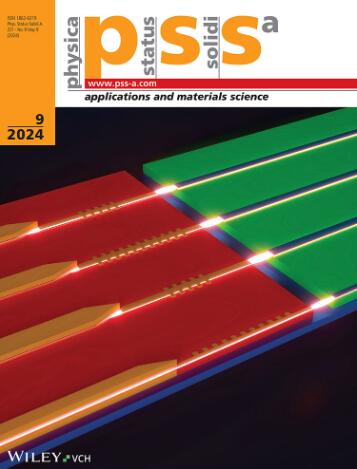纳米结构掺K氧化锌薄膜:合成与研究
IF 1.9
4区 材料科学
Q3 MATERIALS SCIENCE, MULTIDISCIPLINARY
Physica Status Solidi A-applications and Materials Science
Pub Date : 2024-06-24
DOI:10.1002/pssa.202300982
引用次数: 0
摘要
本研究介绍了通过溶胶-凝胶浸涂技术合成的钾掺杂氧化锌薄膜的光学、结构、介电、光催化和抗菌特性,钾掺杂浓度为 (1, 2, 3, 4, 5) wt%。薄膜在最佳温度下退火。掺杂了 K 的氧化锌具有六方菱面体相,并沿 (101) 平面优先取向。随着钾掺杂百分比的增加,晶粒尺寸也随之减小。光学分析表明,当氧化锌中的钾掺杂量增加时,带隙会减小。介电常数实验表明,当钾掺杂百分比增加时,薄膜的交流电导率也会增加。薄膜电阻率和霍尔系数随 K 浓度的增加而降低,但电导率、迁移率和载流子浓度却上升了。革兰氏阳性和革兰氏阴性细菌对掺杂 K 的氧化锌都有反应。掺 K 氧化锌具有这种抗菌特性,可用于生物医学和环境保护。光催化剂 K 掺杂氧化锌能有效降解亚甲基蓝染料,因此可用于去除废水中的污染。本文章由计算机程序翻译,如有差异,请以英文原文为准。
Nanostructured K‐Doped ZnO Thin Films: Synthesis and Investigations
The present research describes the optical, structural, dielectric, photocatalytic, and antibacterial characteristics of potassium‐doped ZnO thin films synthesized via sol–gel dip coating technique with a K doping concentration of (1, 2, 3, 4, 5) wt%. Thin films are annealed at optimized temperatures. K‐doped ZnO has a hexagonal wurtzite phase having a preferential orientation along the (101) plane. The size of the crystallite decreases as the potassium doping percentage rises. Optical analysis reveals that the bandgap decreases when the quantity of K doping in ZnO increases. Dielectric constant experiments show that when the K doping % is raised, AC conductivity of thin films rises as well. Thin film resistivity and Hall coefficient decrease with increasing K concentration, but conductivity, mobility, and carrier concentration rise. Gram‐positive and gram‐negative bacteria are both responsive to K‐doped ZnO. With such antibacterial properties, K‐doped ZnO can be used in biomedicine and to protect the environment. The methylene blue dye is effectively degraded by the photocatalyst K‐doped ZnO, making it useful for removing pollution from wastewater.
求助全文
通过发布文献求助,成功后即可免费获取论文全文。
去求助
来源期刊
CiteScore
3.70
自引率
5.00%
发文量
393
审稿时长
2 months
期刊介绍:
The physica status solidi (pss) journal group is devoted to the thorough peer review and the rapid publication of new and important results in all fields of solid state and materials physics, from basic science to applications and devices. Among the largest and most established international publications, the pss journals publish reviews, letters and original articles, as regular content as well as in special issues and topical sections.

 求助内容:
求助内容: 应助结果提醒方式:
应助结果提醒方式:


